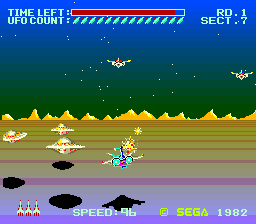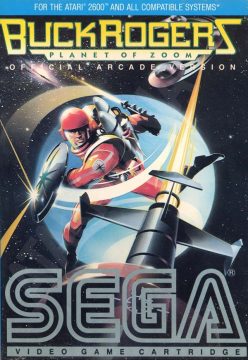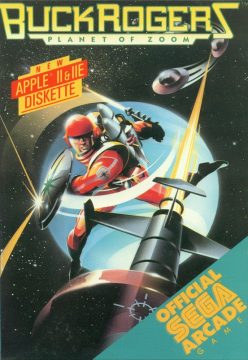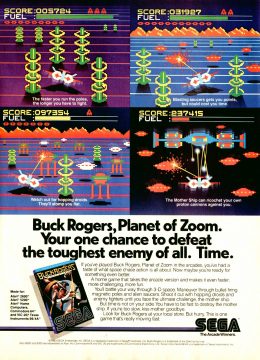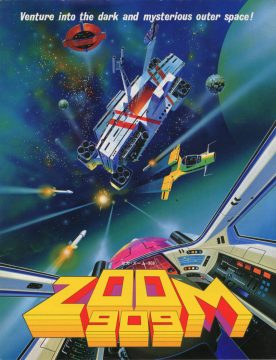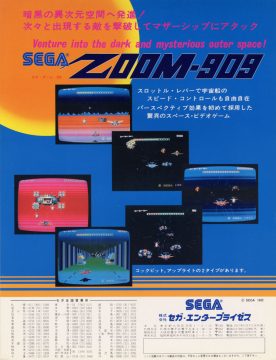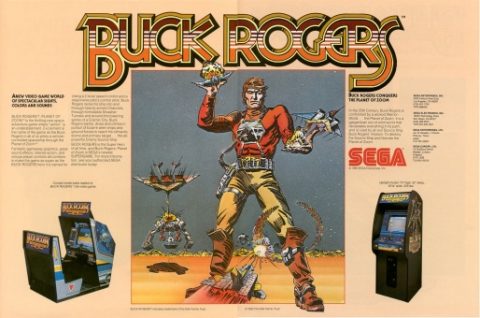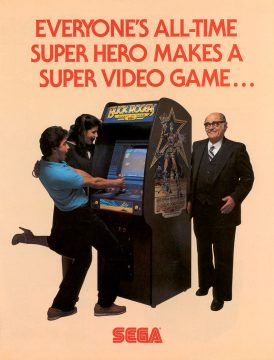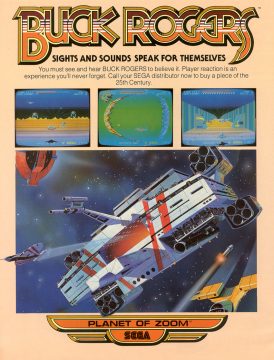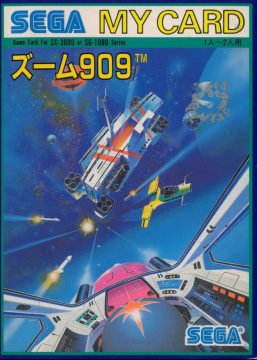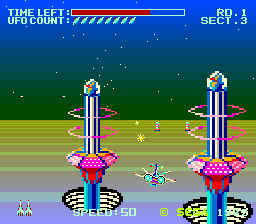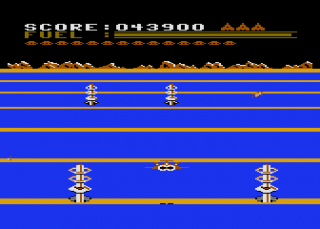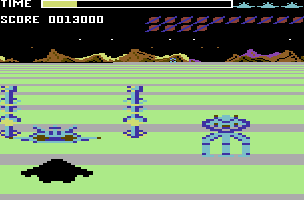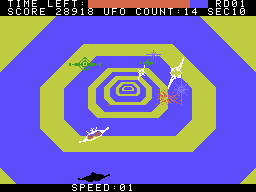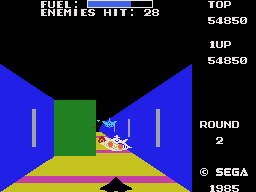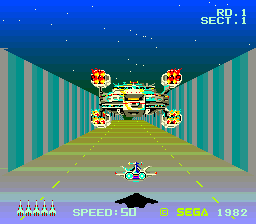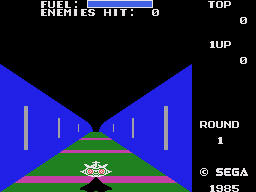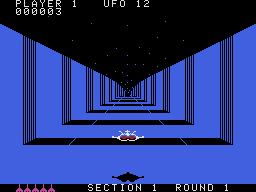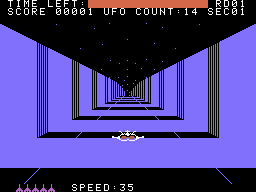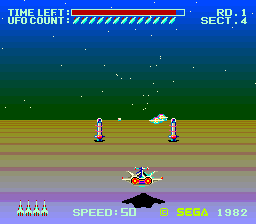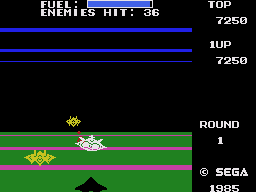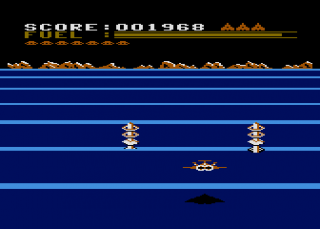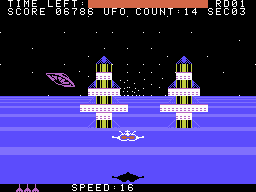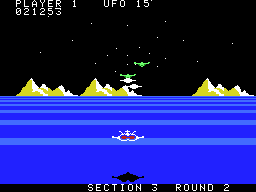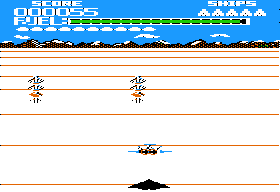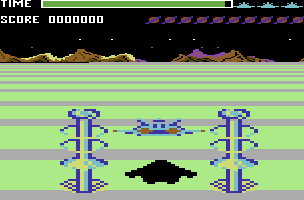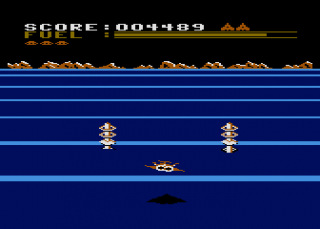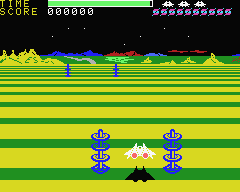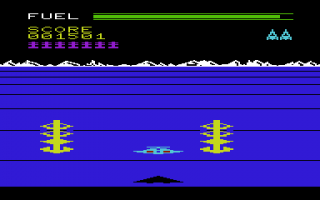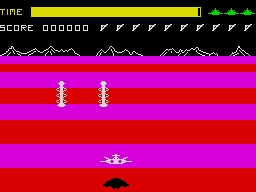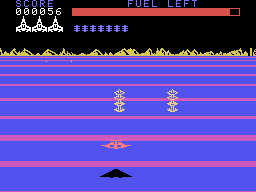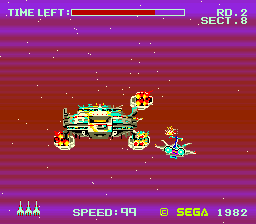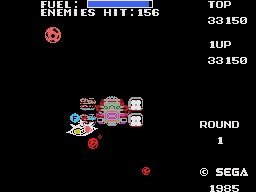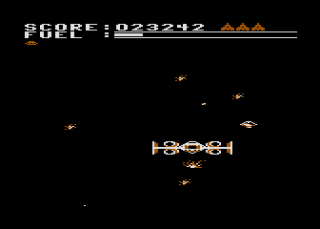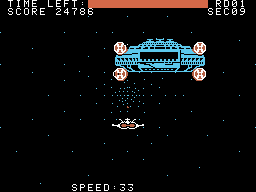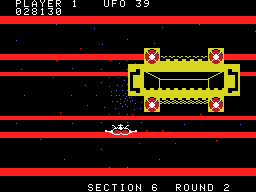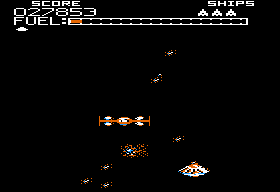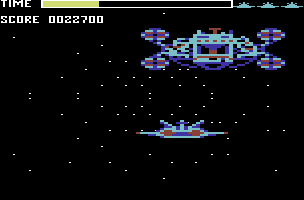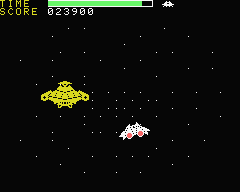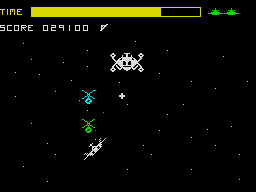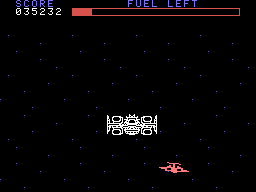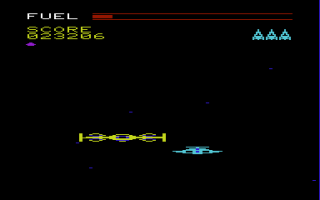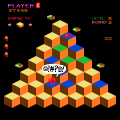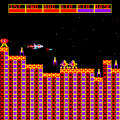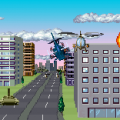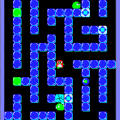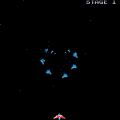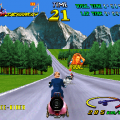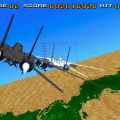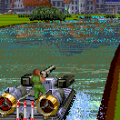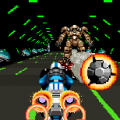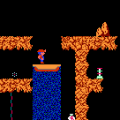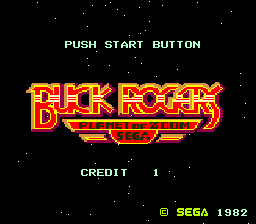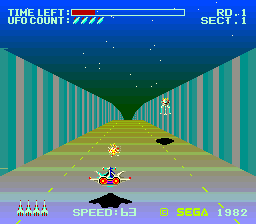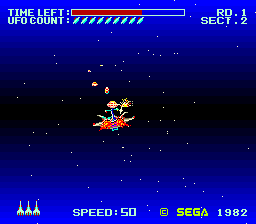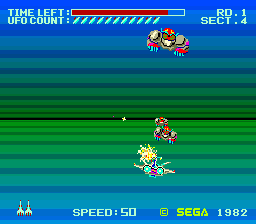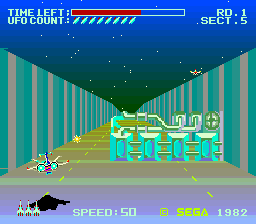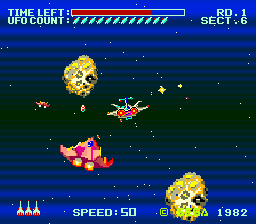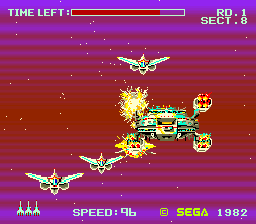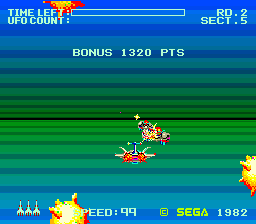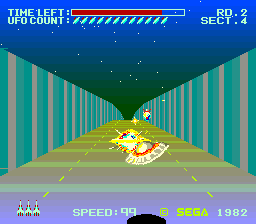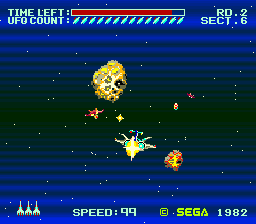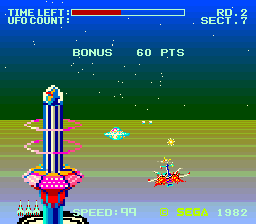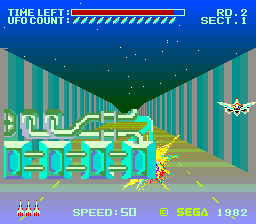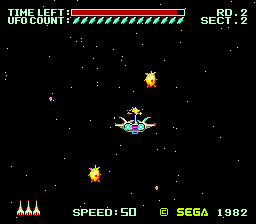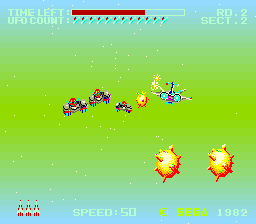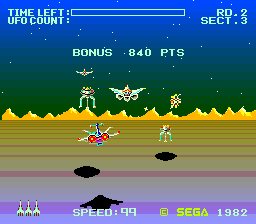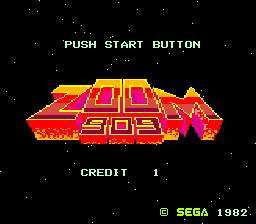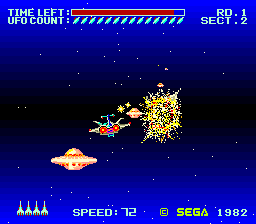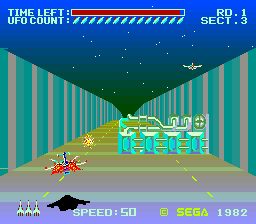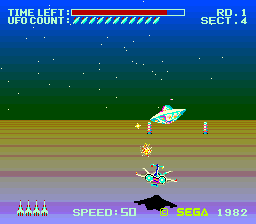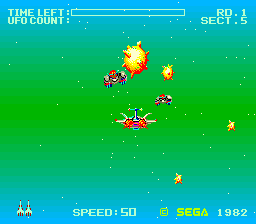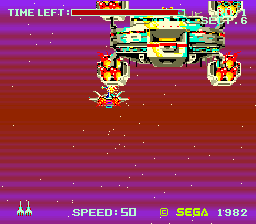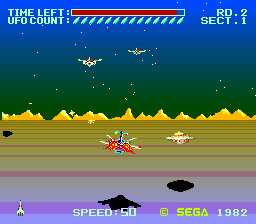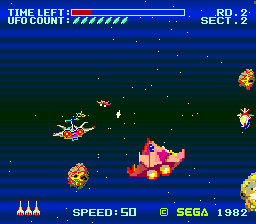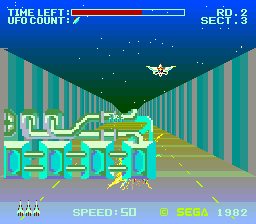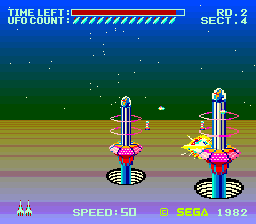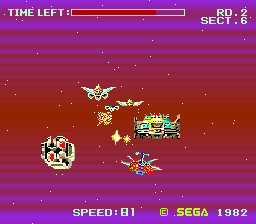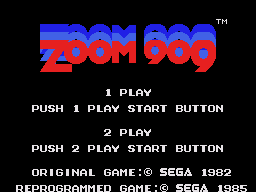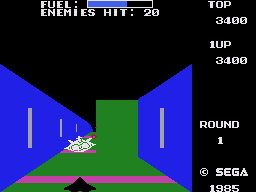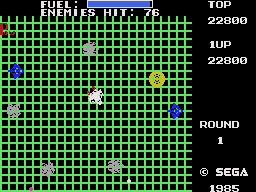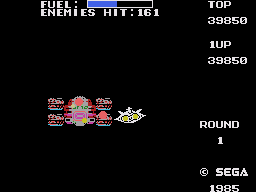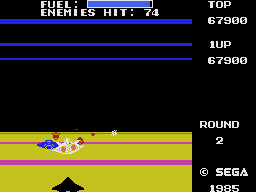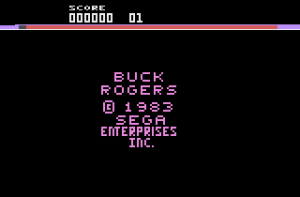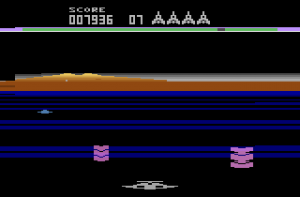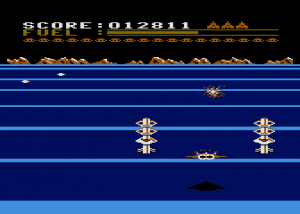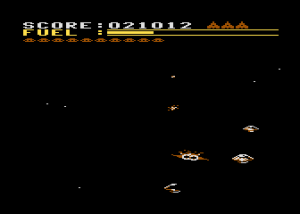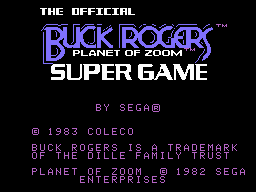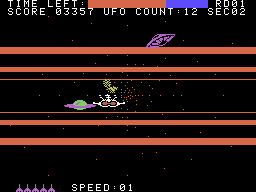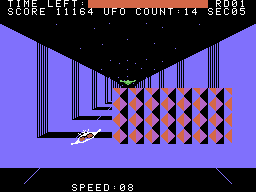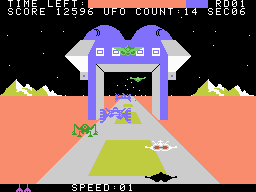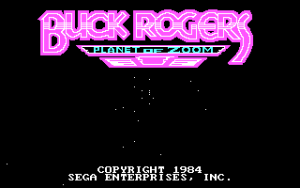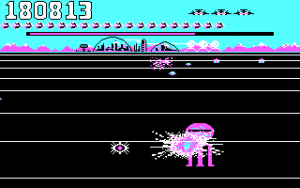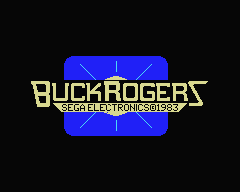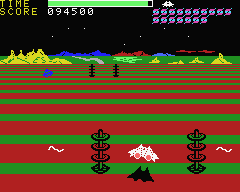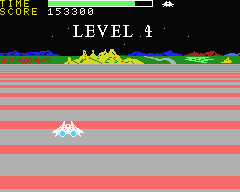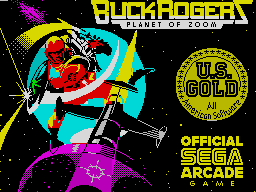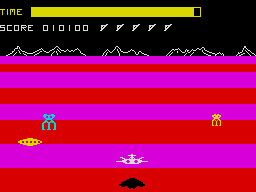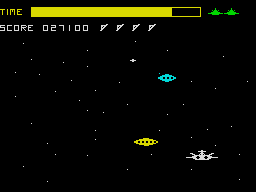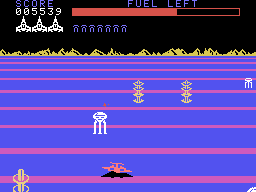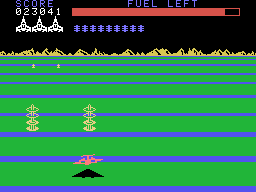When the first Star Wars movie opened in theaters in 1977, it had a tremendous impact on pop culture in general, and everything space opera, in particular. Needless to say, countless space combat video games in the late 70s and early 80s owed a lot to the film. Perhaps the most iconic action scene of A New Hope is the attack on the Death Star and the chase through the trenches on its surface. This part was copied several times even before Atari got to make its official vector graphics tie-in arcade game. That must have been the premise for Zoom 909: “Let’s make a space shooting game that’s like the attack on the Death Star in Star Wars!”
Sega had first explored sprite-scaling 3D the year before with the racing game Turbo, and Zoom 909 followed as the foundation for the second mainstay of their sprite scaler games, third person rail shooters. The player took a seat in a futuristic space ship – preferably actually sitting inside the comfy cockpit cabinet – to hunt down an alien mother ship through six stages. After the initial run through the presumed Death Star trench follows a flight through outer space, a variant of the trench with approaching walls to dodge, a swoop over a planet surface with strange pillar gates to pass, a mine field where the mines and enemies are invisible most of the time, and finally the decisive battle against the mother ship.
All stages have that distinct theme park ride mentality many of Sega’s later Super Scaler games were known for; the game runs constantly on a timer, but running out of time doesn’t end the game – it simply concludes the stage and moves on to the next. There’s a certain amount of enemies to defeat or gates to pass in each scene that’s rewarded with a bonus, but that’s easier said than done. It’s possible to speed up the ship to increase the score, but the pace is frenetic enough without ever touching the throttle.
The final showdown is also more of a setpiece rather than a traditional boss battle, and the mother ship, which keeps spitting out fighter drones at the hero, is defeated by shooting out all of its four engines before destroying the main body. After the fight, the game starts looping indefinitely, but the order of the stages is mixed up, even introducing some new setups, such as an all-out planetary battle without the gates, and an asteroid field in space.
When the game was brought to the US, someone had the brilliant idea to tie it in with a popular sci-fi franchise. Sega didn’t quite manage to get the Star Wars license – which presumably was already in the hands of Atari – and Star Trek had just been used up for the American-developed vector game. The classic pulp novel hero and aged American pop culture icon Buck Rogers had just been dusted off for a cinema and TV revival a few years prior, though, and was available for a video game deal. Aside from adequate promotional artwork, no attempts were made to liken Zoom 909 to the license. After all, this was long before video games in general would become anything resembling the movies they were based on.
A few other tweaks had been made to the game, though. One loop now lasts eight stages instead of six, incorporating every available stage type before the boss. Their order has been changed around, as well, but it all still starts with the mother ship escaping through the Death Star tunnel.
Even with the added length of a single loop, beyond the first 10 minutes of play, Buck Rogers: Planet of Zoom still has to rely on little more than its show value and the hunt for higher scores. Oddly, your score isn’t reset when using a credit, and since the game goes on forever, the high score loses all meaning outside of a controlled, house rule environment. This is too bad, as the time and speed bonuses could have made for interesting score play.
While the success of Planet of Zoom was heavily dependent on the arcade experience, Sega of America apparently wasn’t intent to let the license go to waste – they even aired a hilariously bad TV commercial, and ported the game to almost all available home platforms by late 1983. The first batch of home conversions included the Atari 2600, Atari 5200, Atari’s 8-bit computers, Commodore 64, VIC-20, and Texas Instruments-99/4A. It was to be expected that they all had to compromise in some form or another, but the cuts couldn’t have been more damaging. Perhaps caused by fear of legal conflict with Atari, who had their Star Wars arcade game out by then, the exciting trench levels are gone entirely, and with them the asteroid and mine fields.
Instead, the adventure opens with the pole gate scene on the planet surface, which is divided into three phases. The first is dedicated to flying through the gates, which send electric shocks outwards to punish players who miss them. Then the flying saucers attack, and finally the bouncing Space Hoppers dominate the third phase. Afterwards, the ship takes flight into outer space, where more saucers wait to get shot and the boss appears. That’s it. Of course all versions keep looping around, but the only differences each time are altered color schemes for the planet surface, and higher requirements to finish a scene.
In place of the time limit system from the arcade, the home versions use a limited fuel supply: If the ship runs out of fuel, you get sent back to the very beginning of the loop. The ship is only ever refueled after defeating the mother ship, so this can get quite frustrating. The controls are also a bit weird, because the speed can only be changed by pressing Up or Down after the ship is at maximum/minimum height. Worse than all that, though, the action just isn’t that exciting without the speed and the flash of the arcade machine.
The Atari 2600 version is a bit different from the rest, as there is no flying height and no transitions between the ground phases, of which there are only two. This makes the game feel very fast-paced compared to the other ports. The saucers in outer space also always fly in formation, and the boss consists of just two parts that keep retreating into the background and then flying at the player with rapid speed. The Texas Instruments one also has only two ground phases, and the first just has the gates to fly through, while the second is exclusively for shooting Space Hoppers, as the gates do nothing.
The rest of the ports are mostly the same, aside from the differences in controls, graphics, and sound. The C64 version is actually much more lenient than the rest, though, because it recharges fuel whenever you lose a ship, and running out of it also doesn’t set you back. Unfortunately, the view appears incredibly zoomed-in, so much so that it’s often impossible to see the gate posts at the beginning of a stage. The mother ship in this version is ridiculously easy, though, as a single hit is enough to destroy it.
The later released Apple II and IBM PC versions follow the same template as the other computers, but suffer from horrible keyboard controls. They also introduce a space station that draws nearer with each round – at least for the first five loops. Afterwards, it turns into the same repetition of color swaps as the rest of the ports.
U.S. Gold brought the C64 game to Europe, and also commissioned a Spectrum port for the UK. It turns out the horrible scrolling of the hardware also translates to pseudo-3D games, making the planet surface appear to just swap the two ground colors rather than scrolling them – definitely not recommended for epileptics.
Also exclusive to PAL territories was the MSX version by Philips, which adds an interesting feature – pressing downwards actually makes the ship tilt, allowing it to shoot backwards at enemies that approach from behind. It isn’t too intuitive, but makes for a welcome twist in an otherwise dull game.
Needless to say, this complete line of adaptations was reviewed as poorly as they were, but it wasn’t all garbage for Buck Rogers at home. A completely different take on the original was created in time for the release of Coleco’s new Adam computer in October 1983, and actually bundled with the system to showcase its capabilities, with a standalone version for the ColecoVision becoming available later, too. This is the real stuff.
Believe it or not, the ColecoVision was practically the Dreamcast of 1982, and in its time had been famous for its particularly accurate arcade ports. When booting the game up after experiencing all the terrible ports, the first level comes as quite a shock: It’s the Death Star trench stage! Not only that, the game contains almost all the stages from the arcade game, too. The mother ship even has its four separate engines to shoot out. The additional buttons on Coleco’s controllers also allow for separate speed control, making this conversion nearly perfect.
This version was already leagues better than all the previously described ports, but not enough. With the Adam computer, Coleco offered an enhanced Super Game Pack version (which was actually on a tape, despite the name), which gave new twists to some of the stages. The gate posts on the first planet surface stage are now huge towers, even though their placement oddly shifts as the ship approaches them, and the mine fields that had been missing in the first release are back. The game actually even expands upon the original, introducing a completely new stage where you fly along a road through enormous arcs, while four-legged alien creatures and tanks shoot at you from the ground. After defeating the mother ship – which has been redesigned from its initial, quite-blocky appearance – you’re not taken immediately to the next loop, but first are sent through a psychedelic wormhole full of hazardous sparks.
“Super Buck Rogers“, as this enhanced version was often called, was also supposed to come out for the ColecoVision, but as Coleco canceled the expansion module it would have required, console owners had to be content with the stripped-down version. Sega had also announced a version for the Mattel Intellivision, but like most of the titles they had planned for the system, it was scrapped.
Even though the SG-1000 was released in 1983, Sega had been rather slow at supplying it with a decent software library, and thus Sega of Japan’s only home port of Zoom 909 didn’t come out before 1985. It wasn’t as good as Coleco’s versions, but at least it had the trench stage in both its variations, a plain planet surface stage, and the authentic boss battle.
Before that showdown comes a really odd feature, though: For one stage per loop, the gameplay changes completely to a top-down shooter, which plays like Asteroids on an endlessly scrolling grid full of planetoids and other hazards. The controls here are extremely sensitive, though, and it’s easy to run into enemies. Fortunately, the stage is littered with power-ups that make the ship indestructible, and the trick is to keep collecting them, staying invincible for as long as possible. The game also seems to have adopted the fuel system from the Western-made ports, except fuel can – and needs to – be recharged through power-ups that appear throughout the game.
Like so many SG-1000 games, Pony Canyon made a conversion for MSX computers, so two completely different takes on the game exist for the same hardware. This was the last of the Planet of Zoom, though. The game has never showed up in any of Sega’s many compilations, perhaps in part due to the license (although that wouldn’t have been an issue in Japan), but certainly also because of its very short-lived success. There’s also the fact that it was completely overshadowed by Yu Suzuki’s later Super Scaler shooters Space Harrier and After Burner. Still, it’s a fascinating part of Sega’s history, and it would be great if they remembered it at some point.
Screenshot Comparisons
